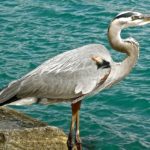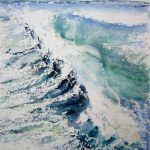 It would be highly unusual to run into an elk on one of the islands in the Salish Sea. Whale in the sea, yes. A farmer with an exotic zebra or even a giraffe, maybe. But an elk in the wild? Only on Whidbey. His name is Bruiser and he has even had an exclusive interview printed in the Sunday Seattle Times.
It would be highly unusual to run into an elk on one of the islands in the Salish Sea. Whale in the sea, yes. A farmer with an exotic zebra or even a giraffe, maybe. But an elk in the wild? Only on Whidbey. His name is Bruiser and he has even had an exclusive interview printed in the Sunday Seattle Times.
We thought Bruiser was as unusual as it got on the island until the recent Open Studio Tour, a look at artists and their work, sponsored by Whidbey Working Artists. Carefully, we looked through the guide of over 42 artists, read about their art, and mapped out a plan to see as much as we could in a day.
Our plan was undone at the very first stop.
We anticipated artists and their various passions. We wanted to see studios and the supplies and equipment used to create. But we didn’t expect…
![]()
We left Coupeville on a typical country road, following our map and enjoying the sun. A blue mailbox with a big black crow showed us where to turn. The road bumped, tall grasses swung gently as we drove by and there were crows. Calling. We parked on the edge of a small meadow and walked the remaining curves in the road.
A citrusy scent pulled us along until we saw a giant-sized garden. Eight-foot-tall climbing roses and sunflowers wove over and about the fence. Fruit trees wept with ripe pears and apples. Showy flowers competed to see which was the brightest and best. Chickens clucked in the background and for a moment, I thought I saw a girl bending to collect an egg. But no, only a pair of crows pecking at the ground. The ogress in the book I recently reviewed would have enjoyed them.
A bold sign announced we were there: Crow Valley Arts.

Standing to greet us was the artist, Diane Tompkinson. We met once before at the Penn Cove Gallery in Coupeville. She had been warm and effusive about her art. Known for her printmaking and painting we were thrilled to see her surrounded by proof of her colossal creativity.
We talked about prints, techniques, equipment, being creative, gardening, baking, teaching and more. It felt like I knew her, not only her art but also her story. Had I read about her?
This woman is impressive. Tall, strong shouldered and with expressive hands. She smiled, beamed actually, the entire time we were with her. Listening with as much interest to our prattle as we did to her, she made us feel welcome. We heard tales of art school, living in a variety of locales, teaching, learning to carve, finding a piece of earth to call home and well, nesting. Her art reveals her love of birds, particularly raptors, and their enemies, the crow family. It also shows her fascination with the sea, the forest, the islands, and their inhabitants. She sells cards, prints, and paintings. And gives away joy for free.
 I grinned at Diane, enchanted. As she showed us her press and talked about working with paper and ink, I knew who she was. Or who she was related to. In The Ogress and the Orphans by Kate Barnhill (see MG Books on the menu above) there is a female ogress. She is not a people eater; she is a caring people lover.
I grinned at Diane, enchanted. As she showed us her press and talked about working with paper and ink, I knew who she was. Or who she was related to. In The Ogress and the Orphans by Kate Barnhill (see MG Books on the menu above) there is a female ogress. She is not a people eater; she is a caring people lover.
Both are gregarious, welcoming others with open arms. Both are skilled at gardening, home building, and baking. They are endlessly creative, embracing multiple art forms and mastering them all. They are happy, kind, full of life and respectful of life. Crows are their friends.
 Visit Diane Tompkinson at Crow Valley Arts, and discover her art. Read The Ogress and the Orphans and learn about being a good neighbor.
Visit Diane Tompkinson at Crow Valley Arts, and discover her art. Read The Ogress and the Orphans and learn about being a good neighbor.
Keep your eyes open, where there is art and magic, there might be an ogress!
Ina Orme
PS Crow prints by Diane Tompkinson.

 Whidbey is a long zig zag of an island in Washington State. From end to end it’s about 55 miles in length and narrow. Rooted in the Salish Sea, it sprawls between Seattle and Canada.
Whidbey is a long zig zag of an island in Washington State. From end to end it’s about 55 miles in length and narrow. Rooted in the Salish Sea, it sprawls between Seattle and Canada.


